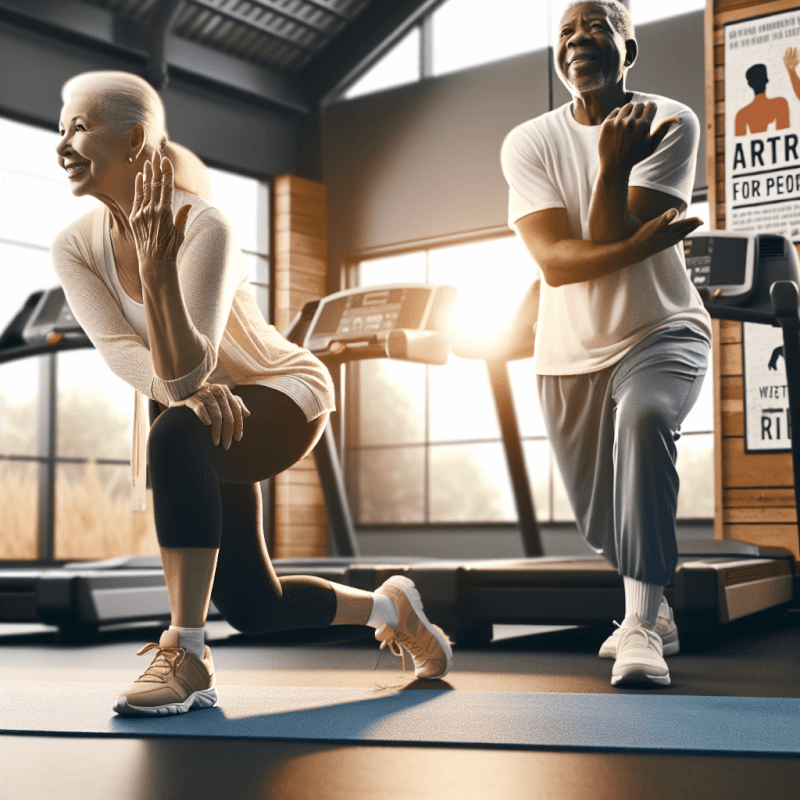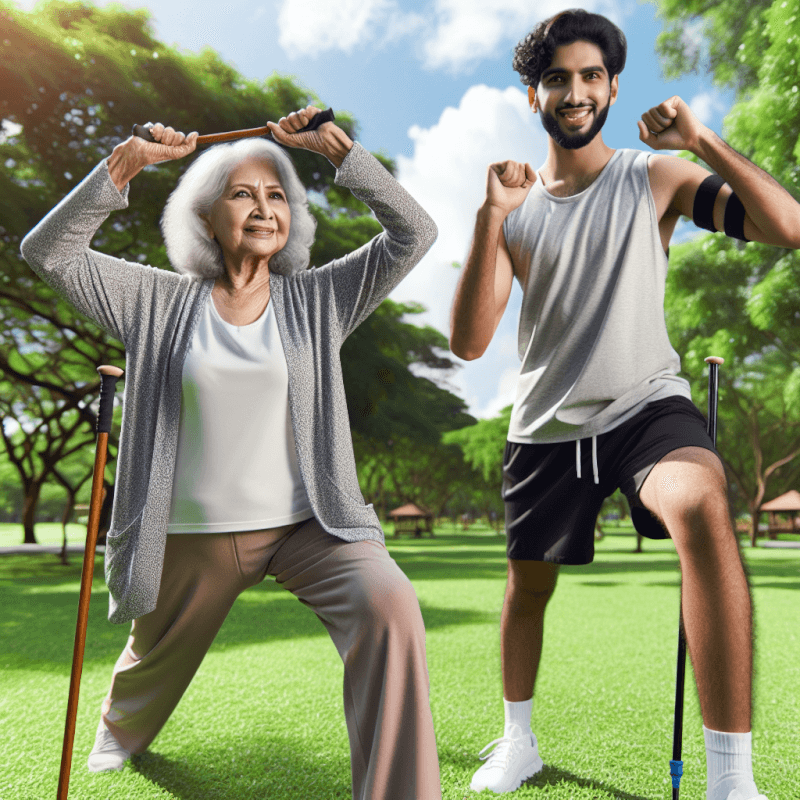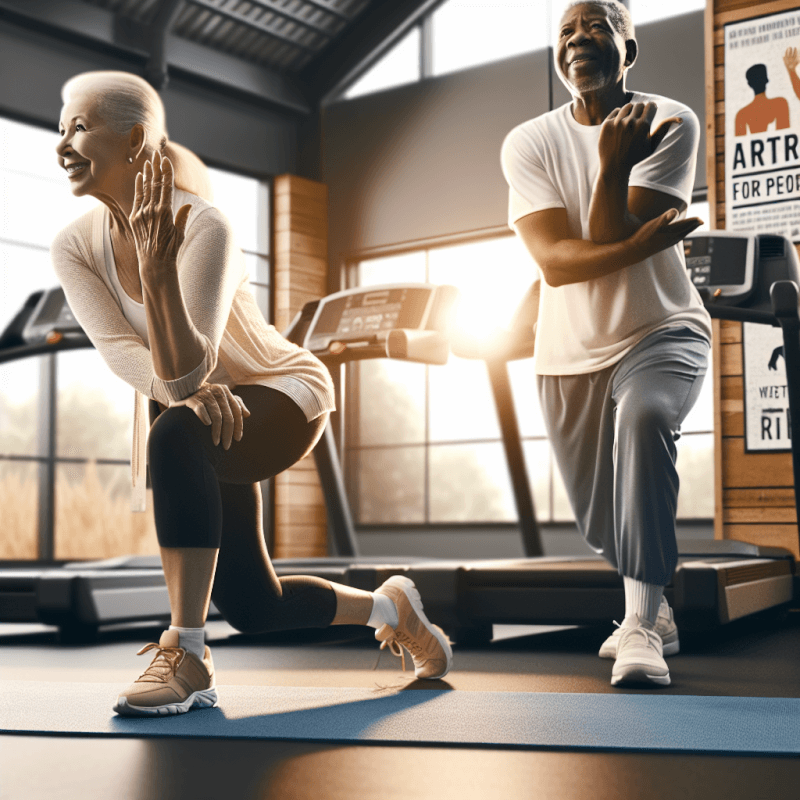If you’ve been diagnosed with arthritis, you may be wondering how to safely increase your physical activity without exacerbating your symptoms. Fortunately, there are ways to stay active and maintain a healthy lifestyle, even with arthritis. In this article, we’ll explore some practical tips and strategies that can help you safely increase your physical activity while managing your arthritis effectively. So, let’s dive in and discover how you can stay active and lead a fulfilling life, regardless of your arthritis condition.
What is arthritis?
Definition of arthritis
Arthritis is a medical condition characterized by inflammation and stiffness of the joints, which can result in pain and limited mobility. It is a common condition that affects millions of people worldwide. There are different types of arthritis, each with its own causes and symptoms.
Types of arthritis
There are over 100 different types of arthritis, but the most common ones are osteoarthritis and rheumatoid arthritis. Osteoarthritis is a degenerative joint disease that occurs when the cartilage that cushions the joints breaks down over time. Rheumatoid arthritis, on the other hand, is an autoimmune disease where the immune system attacks the joints, causing inflammation and pain.
Importance of physical activity for arthritis
Benefits of physical activity
Engaging in regular physical activity is crucial for managing arthritis symptoms and improving overall quality of life. Regular exercise can help reduce pain, increase joint flexibility and range of motion, strengthen muscles, and improve mood and mental well-being. Physical activity also helps maintain a healthy weight, which is important for arthritis management.

Managing arthritis symptoms through exercise
Exercise plays a vital role in managing arthritis symptoms. It helps to relieve joint stiffness, reduce swelling, and increase lubrication in the joints. By strengthening the muscles around the joints, exercise helps stabilize them and improves their function. Furthermore, physical activity can enhance cardiovascular health and boost the immune system, leading to a reduced risk of other health conditions.
Consultation with healthcare professional
Importance of consulting healthcare professional
Before starting any exercise program, it is essential to consult a healthcare professional, such as a doctor or a physical therapist. They can provide personalized advice and recommendations based on your specific condition and medical history. A healthcare professional can assess your joints, determine the appropriate level of activity, and suggest modifications to ensure your safety and maximum benefit from exercise.
Choosing the right physical activities for your condition
Every person with arthritis may have different needs and limitations. It is crucial to select physical activities that are suitable for your specific condition. Depending on the type and severity of arthritis, certain exercises may be more beneficial than others. Consultation with a healthcare professional will help in deciding which activities are safe and effective for you.

Discussing any concerns or limitations
It is important to share any concerns or limitations you may have with your healthcare professional. They can address your worries, provide guidance on exercises to avoid, and suggest alternative options. Open communication with your healthcare professional will facilitate a safe and effective exercise plan that meets your specific needs and goals.
Understanding arthritis-friendly exercises
Low-impact exercises
Low-impact exercises are gentle on the joints and are highly recommended for people with arthritis. Walking, swimming, and cycling are great examples of low-impact activities. These exercises help improve cardiovascular health, increase muscle strength, and reduce joint stress.
Range-of-motion exercises
Range-of-motion exercises aim to improve joint flexibility and maintain or increase the range of motion in the affected joints. These exercises involve moving the joints in various directions without causing pain. Examples include gentle stretching, yoga, and tai chi. Range-of-motion exercises can help alleviate stiffness, reduce joint pain, and enhance joint function.

Strengthening exercises
Strengthening exercises focus on increasing muscle strength to provide better support and stability to the joints. Resistance training, using weights or resistance bands, is an effective way to strengthen the muscles surrounding the joints. These exercises can improve joint function, reduce pain, and prevent further damage.
Aerobic exercises
Aerobic exercises, also known as cardiovascular exercises, increase the heart rate and offer numerous health benefits. These exercises can be low-impact and include activities such as brisk walking, swimming, or using an elliptical machine. Aerobic exercises improve cardiovascular fitness, promote weight loss, and enhance overall well-being.
Starting slow and gradually increasing intensity
Importance of starting slow
When beginning an exercise routine, it is crucial to start slowly, especially if you have arthritis. Starting with low-impact exercises at a comfortable intensity allows your body to adapt gradually. It helps prevent injuries and reduces the risk of excessive joint pain or inflammation.

Gradually increasing duration and intensity
As your body becomes accustomed to the exercise, you can gradually increase the duration and intensity. This progression helps build strength and endurance over time. It is important to listen to your body and make adjustments accordingly. If you experience excessive pain or discomfort, it may be necessary to scale back on the intensity or the duration of your workout.
Listening to your body
Listening to your body is essential in managing arthritis and avoiding overexertion. Pay attention to any pain, discomfort, or swelling during or after exercise. If you notice any persistent or worsening symptoms, it is important to consult your healthcare professional. They can provide guidance on modifying your exercise routine to ensure it is safe and beneficial.
Joint protection techniques
Using assistive devices
Assistive devices can be valuable tools in protecting your joints while engaging in physical activity. Items such as braces, splints, or orthotics can help provide support and reduce stress on the joints. Using appropriate footwear with cushioning and shock absorption is also important for joint protection during exercise.

Proper body mechanics
Maintaining proper body mechanics during exercise is crucial to prevent joint strain and minimize the risk of injury. It is essential to use correct posture and alignment while performing exercises. Avoiding stress on the joints by distributing the workload evenly across your body can help protect your joints.
Avoiding repetitive high-impact movements
High-impact activities, such as running or jumping, can put excessive stress on the joints and exacerbate arthritis symptoms. It is important to choose exercises that are low-impact and gentle on the joints. Repetitive motions should also be avoided to prevent overuse injuries. Mixing up your exercises and incorporating a variety of movements can help reduce joint strain.
Warming up and cooling down
Benefits of warming up and cooling down
Warming up and cooling down are essential components of any exercise routine, especially for people with arthritis. Warming up prepares the body for activity by increasing blood flow to the muscles and joints, loosening them up, and reducing the risk of injury. Cooling down allows the body to gradually return to a resting state, preventing post-exercise muscle stiffness and soreness.
Recommended stretches and exercises
Before starting your exercise routine, it is helpful to perform some gentle stretching exercises. This can include stretching major muscle groups and targeting specific areas affected by arthritis. Your healthcare professional can provide guidance and recommend specific stretches or exercises that are appropriate for your condition.
Pain management strategies
Using hot or cold therapy
Hot and cold therapy can provide temporary relief from arthritis pain and inflammation. Applying a warm compress or taking a warm bath can help relax muscles and reduce stiffness. Cold therapy, such as ice packs or cold packs, can numb the affected area and reduce swelling and inflammation. It is important to use these therapies as directed and consult your healthcare professional for guidance.
Taking over-the-counter pain relievers
Over-the-counter pain relievers, such as acetaminophen or nonsteroidal anti-inflammatory drugs (NSAIDs), can be used to manage mild to moderate arthritis pain. It is important to follow the recommended dosage and consult your healthcare professional before taking any medications, especially if you have pre-existing medical conditions or are taking other medications.
Using topical creams or ointments
Topical creams or ointments that contain ingredients like menthol or capsaicin can provide localized relief from arthritis pain and inflammation. These products work by numbing the area or stimulating blood flow to the affected joint. It is important to read and follow the instructions on the packaging and consult your healthcare professional if you have any concerns.
Utilizing relaxation techniques
Relaxation techniques, such as deep breathing, meditation, or guided imagery, can help manage arthritis pain by reducing stress and promoting relaxation. Stress can worsen pain perception and increase muscle tension. Incorporating relaxation techniques into your daily routine can help reduce arthritis-related stress and improve overall well-being.
Incorporating flexibility exercises
Adding flexibility exercises to your routine
Flexibility exercises, including stretching, help improve joint mobility and range of motion, making daily activities easier to perform. It is important to incorporate specific flexibility exercises into your routine that target the major muscle groups and joints affected by arthritis. Your healthcare professional can provide guidance on the most effective exercises for your specific condition.
Stretching major muscle groups
Stretching major muscle groups, such as the hamstrings, quadriceps, hips, back, and shoulders, can help relieve muscle tension and improve overall flexibility. It is important to perform static stretches (holding a position for about 30 seconds) after warming up or during the cooldown phase of your exercise routine. This will help maximize the benefits of stretching and reduce the risk of injury.
Importance of rest and recovery
Recognizing the need for rest
Giving yourself time to rest is just as important as engaging in physical activity. Rest allows your body to recover from exercise-induced stress and gives your joints a break. It is essential to listen to your body and recognize when you need rest. Overdoing it can lead to increased pain and potential injury.
Allowing time for recovery
Recovery plays a crucial role in the body’s ability to repair and adapt to exercise. It is important to allow your body enough time between exercise sessions to recover. This includes getting enough sleep, eating a nutritious diet, and practicing self-care techniques, such as relaxation and stress management.
Balancing rest with physical activity
Finding a balance between rest and physical activity is key to effectively managing arthritis. It is important to engage in regular exercise to maintain joint health, but also to give yourself adequate rest periods. Consult with your healthcare professional to develop a balanced exercise routine that takes into account your individual needs and limitations.
In conclusion, maintaining a physically active lifestyle is essential for managing arthritis symptoms and improving overall well-being. By consulting with a healthcare professional, understanding arthritis-friendly exercises, gradually increasing intensity, using joint protection techniques, practicing proper warm-up and cool-down routines, utilizing pain management strategies, incorporating flexibility exercises, and balancing rest with physical activity, you can safely increase your physical activity levels and enhance your quality of life. Remember to always listen to your body, prioritize self-care, and consult your healthcare professional for personalized advice.


